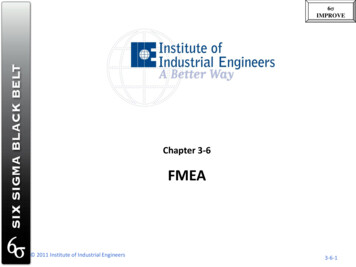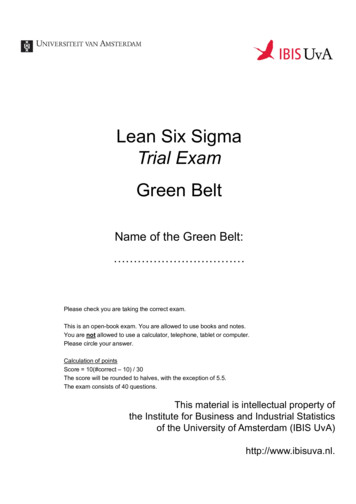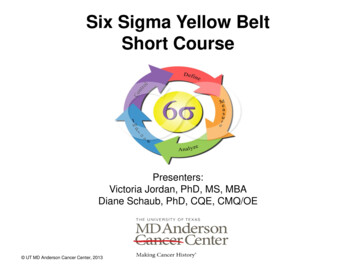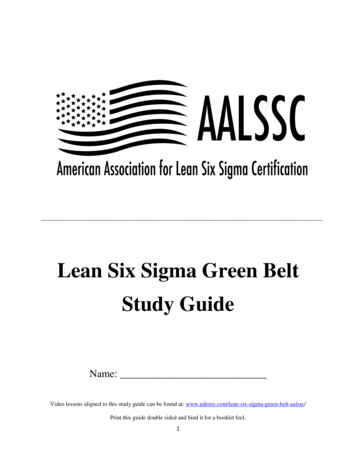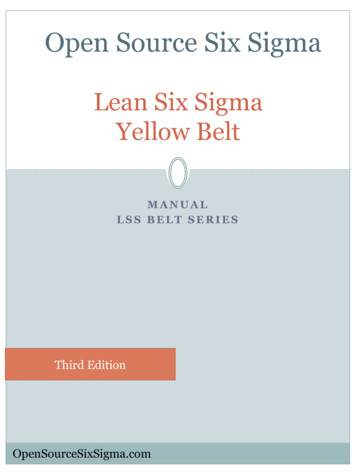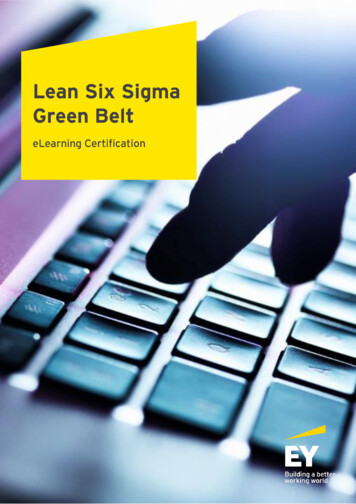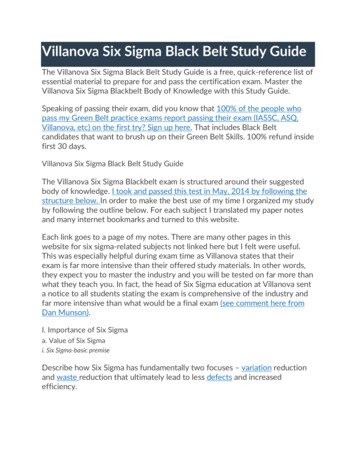
Transcription
Villanova Six Sigma Black Belt Study GuideThe Villanova Six Sigma Black Belt Study Guide is a free, quick-reference list ofessential material to prepare for and pass the certification exam. Master theVillanova Six Sigma Blackbelt Body of Knowledge with this Study Guide.Speaking of passing their exam, did you know that 100% of the people whopass my Green Belt practice exams report passing their exam (IASSC, ASQ,Villanova, etc) on the first try? Sign up here. That includes Black Beltcandidates that want to brush up on their Green Belt Skills. 100% refund insidefirst 30 days.Villanova Six Sigma Black Belt Study GuideThe Villanova Six Sigma Blackbelt exam is structured around their suggestedbody of knowledge. I took and passed this test in May, 2014 by following thestructure below. In order to make the best use of my time I organized my studyby following the outline below. For each subject I translated my paper notesand many internet bookmarks and turned to this website.Each link goes to a page of my notes. There are many other pages in thiswebsite for six sigma-related subjects not linked here but I felt were useful.This was especially helpful during exam time as Villanova states that theirexam is far more intensive than their offered study materials. In other words,they expect you to master the industry and you will be tested on far more thanwhat they teach you. In fact, the head of Six Sigma education at Villanova senta notice to all students stating the exam is comprehensive of the industry andfar more intensive than what would be a final exam (see comment here fromDan Munson).I. Importance of Six Sigmaa. Value of Six Sigmai. Six Sigma-basic premiseDescribe how Six Sigma has fundamentally two focuses – variation reductionand waste reduction that ultimately lead to less defects and increasedefficiency.
Understand the concept of variation and how the six Ms have an influence onthe process. Understand the difference between assignable-cause andcommon cause variation along with how to deal with each type.ii. Historyof organizational improvement/foundations of Six SigmaUnderstand the origin of continuous improvement tools used in Six sigma(e.g. Deming, Juran, Shewhart, Ishikawa, Taguchi, etc.)iii. Quality improvement conceptsDefine and describe concepts such as prevention versus detection, qualitycharacteristics (i.e. nominal-is-best, smaller-is-best or larger-is-best) and howthey apply to target values.iv. Value to the enterpriseRecognize why organizations use Six Sigma, how they apply its philosophy andgoals.Describe how process inputs, outputs, and feedback impact the largerorganization. Critical Success Factors to Six Sigmav. Drivers and metricsRecognize key drivers for business [profit, market share, customer satisfaction,efficiency, product differentiation, defects per million opportunities (DPMO),etc.] and how key metrics are developed and impact the entire organization.vi. FinancialBenefitsUnderstand and present financial measures and other benefits (soft and hard)of a project; understand and use basic financial models (e.g., NPV, ROI);vii. Costof Poor QualityDescribe, apply, evaluate, and interpret cost of quality concepts,including quality cost categories, data collection, reporting, etc.
viii. Business system and processesUnderstand and distinguish interrelationships between business systems andprocesses.b. Voice of the customeri. Customer focusIdentify and classify internal and external customers as applicable to aparticular project, and show how projects impact customers.ii. Collect customer dataUse various methods to collect customer feedback (e.g. Kano diagrams,observation, etc.) and identify key elements that make these tools effective.iii. Analyze customer dataUse graphical, statistical, and qualitative tools to analyze customer feedback.iv. Translatecustomer requirementsAssist in translating customer feedback into project goals and objectives,including critical to quality (CTQ) attributes and requirements statements. Usevoice of customer analysis tools such as quality function deployment(QED) and Kano diagrams to translate customer requirements intoperformance measures.v. Ownersand stakeholdersIdentify process owners, internal and external customers, and otherstakeholders in a project.II. Six Sigma and the organizationa. Six Sigma projectsi. Projectcharter and problem statementDefine and describe elements of a project charter and develop a problemstatement, including baseline and improvement goals.
ii. Charter negotiationCreate and negotiate the charter, including objectives, scope, boundaries,project transition, and project closure.iii. Problem statementDevelop problem statement, including baseline and improvement goals.iv. MetricsEstablish primary and consequential metrics (quality, cycle time, cost)v. Process elementsDefine and describe process components and boundaries.vi. ProcessesRecognize how processes cross various functional areas and the challengesthat result for process improvement efforts.vii. Projectplanning toolsUse project tools such as critical path method (CPM), and program evaluationand review technique (PERT) charts, etc.viii. Project documentationCreate data-driven and fact-driven project documentation using spreadsheets,storyboards, phased reviews, management reviews, presentations to theexecutive team, etc.ix. DMAICDescribe the phases of DMAIC model including tollgate reviews.x. Project metricsAssist with the development of primary and consequential metrics (e.g., qualitytime, cycle time and cost) and establish key project metrics that relate tothe voice of the customer.
xi. Project risk analysisDescribe the purpose and benefit of project risk analysis, includingresources, financials, impact on customers and other stakeholders, etc.xii. Project closureDescribe the objectives achieved and apply the lessons learned to identifyadditional opportunities.b. Teamsi. Initiating teamsKnow the elements of launching a team and why they are important: clearpurpose, goals, commitment, ground rules, roles and responsibilities of teammembers, schedules, and support from management, and team empowerment.ii. Selecting team membersSelect team members that have appropriate skills sets (e.g., self facilitation,technical/subject matter expertise), and create teams with appropriatenumbers of members and representation.iii. Team stages and dynamicsDefine and describe the stages of team evolution, including forming storming,norming, performing. Identify and help resolve negative dynamics such asoverbearing, dominant, or reluctant participants, the unquestioned acceptanceof opinions and facts, groupthink, feuding, floundering, the rush toaccomplishment, etc.iv. Rolesand responsibilitiesDescribe and define the roles and responsibilities of participants on SixSigma and other teams, including Black Belt, Master Black Belt, GreenBelt, champion, coach, facilitator, team member, sponsor, process owner, etc.v. Team toolsDefine, select, and apply team tools such as nominal grouptechnique, multivoting, etc.
vi. Teamfacilitation techniquesApply coaching, mentoring, and facilitation techniques to guide a team andovercome problems such as overbearing, dominant, or reluctant participants,the unquestioned acceptance of opinions as facts, tangents, etc.vii. Team-building techniquesRecognize and apply the basic steps in team building: goals, roles andresponsibilities, introductions and both stated and hidden agendas.viii. Team performance evaluationMeasure team progress in relation to goals, objectives and metrics that supportteam success.ix. Motivation techniquesDefine, select, and apply techniques that support and sustain team memberparticipation and commitment.x. CommunicationUse effective and appropriate communication techniques for differentsituations to overcome barriers to project success.xi. Negotiation and conflict resolution techniquesDefine, select, and apply tools such as consensus techniques, brainstorming,effort/impact, multivoting, interest-based bargaining to help conflicting parties(e.g., departments, groups, leaders, staff) recognize common goals and how towork together to achieve them.c. Change Managementi. Managing changeUnderstand and apply techniques for facilitating or managing organizationalchange through change agent methodologies.
ii. Organizational roadblocksUnderstand the inherent structures for an organization (e.g., its cultures andconstructs) that present basic barriers to improvement; select and applytechniques to overcome them.d. Senior management elementsi. Organizational leadershipUnderstanding the leadership roles in the deployment of Six Sigma.ii. BenchmarkingUnderstand the importance of benchmarking.iii. Strategic planningDescribe the key elements of strategic business planning and describe why it isimportant at the project level and at the top level of an organization.iv. Supply chain managementDescribe why the development of suppliers is important to a Six Sigmainitiative.v. Barriers to implementationDescribe how to handle some of the common barriers to implementation.III. Six Sigma objectivesa. Key process and product/service parameters identifiedIdentify key process input variables and process output variables (SIPOC), anddocument their relationships through relational matrices, etc.Develop and review process maps, flowcharts, failure modes and effectsanalysis (FMEA) etc.b. Measurement systems that are discriminate, repeatable, and reproducible.Calculate, analyze, and interpret measurement system capability using controlchart methods.
c. Processesin statistical controlIdentify, select, construct, and apply the following types of control charts: Xbar and R, XmR, p, np, c, and u.Describe how turning attribute data into variable discrete data.Understand how to make ‘active use’ of attribute data.d. Statistically capable processesIdentify, describe, and apply the elements of designing and conducting processcapability studies, including identifying characteristics, identifyingspecifications, and verifying stability and normalty.Define, select, and calculate Cp and Cpk, and assess process capability.e. Long-term capabilityDescribe the assumptions and conventions that are appropriate when onlyshort-term data are collected and when only attributes data are available.Describe the changes in relationships that occur when long-term data areused, and interpret the relationship between long- and short-term capability asit relates to a 1.5 sigma shift.f. Visual workplace/factoryIdentify the key aspects of a visual workplaceg. Standard workIdentify the key aspects of a standard work.IV. Six Sigma Approacha. Process analysis and documentationi. QualityFunction Deployment (QFD)Describe how House of Quality fits into the overall DFSS process.
ii. ProcessmappingDevelop and review process maps, written procedures, work instructions,flowcharts, etc.iii. Failuremode and effects analysis (FMEA)Define and describe failure mode and effects analysis (FMEA).Describe the purpose and use of scale criteria and calculate the risk prioritynumber (RPN).iv. Datacollection methodsIdentify and classify continuous (variables) and discrete (attributes) data.v. Techniques for assuring data accuracy and integrityDefine and apply techniques such as random sampling, sample homogeneity,etc.vi. Multi-vari studiesCreate and interpret multi-vari studies to interpret the difference betweenwithin-piece, piece-to-piece, and time-to-time variation.b. Probability and statisticsi. Basicprobability conceptsDescribe and apply concepts such as independence, mutually exclusive,multiplication rules, complementary probability, joint occurrence of events, etc.ii. Descriptive statisticsDefine, compute, and interpret measures of dispersion and central tendency,and construct and interpret frequency distributions and cumulative frequencydistributions.
iii. Graphical methodsDepict relationships by constructing, applying and interpreting diagrams andcharts such as stem-and-leaf plots, box-and-whisker plots, run charts, scatterdiagrams etc., and depict distributions by constructing, applying andinterpreting diagrams such as histograms, normal probability plots etc.c. Collecting and summarizing datai. Types of dataIdentify, define, classify and compare continuous (variables) andii. discrete (attributes) data, and recognize opportunities to convert attributesdata to variables measures.iii. MeasurementscalesDefine and apply nominal, ordinal, interval and ratio measurement scales.iv. Methodsfor collecting dataDefine and apply methods for collecting data such as coding data, automaticgaging etc.v. Techniquesfor assuring data accuracy and integrityDefine and apply techniques for assuring data accuracy and integrity suchas random sampling, stratified sampling, sample homogeneity, etc.d. Hypothesisi. Fundamentaltestingconcepts of hypothesis testing1. Statistical vs. practical significanceDefine, compare and contrast statistical and practical significance.2. Significance level, power, type I and type II errorsApply and interpret the significance level, power, type I and type II errors ofstatistical tests.
3. Sample sizeUnderstand how to calculate sample size for any given hypothesis test.ii. Pointand interval estimationDefine and interpret the efficiency and bias of estimators; compute, interpretand draw conclusions from statistics such as standard error, toleranceintervals, and confidence intervals; understand the distinction betweenconfidence intervals and prediction intervals.iii. Test for means, variances, and proportionsApply hypothesis tests for means, variances and proportions, and interpret theresults.iv. Paired-comparison testsDefine, determine applicability, and apply paired-comparison parametrichypothesis tests and interpret the results.v. Goodness-of-fittestsDefine, determine applicability, and apply chi-square tests and interpret theresults.vi. Analysisof Variance (ANOVA)Define, determine applicability, and
The Villanova Six Sigma Black Belt Study Guide is a free, quick-reference list of essential material to prepare for and pass the certification exam. Master the Villanova Six Sigma Blackbelt Body of Knowledge with this Study Guide. Speaking of passing their exam, did you know that 100% of the people who pass my Green Belt practice exams report passing their exam (IASSC, ASQ, Villanova, etc) on .



